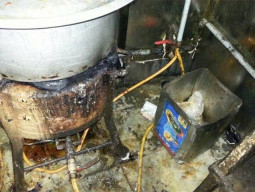
Twelve days after the head of the Jeay Sindh Qaumi Mahaz Bashir Qureshi died in Sakrand in mysterious circumstances, an investigation has revealed that a quantity of the chemical element phosphorus was found in his body.
But was the chemical present in a poisonous quantity? This is still up in the air as the government facilities are not equipped to determine this.
Dr Umer Memon, the head of the 15-member committee constituted by the Sindh health department to examine the cause of Qureshi’s death, shared the investigation report at a press conference at the department with the Additional Secretary of Health Dr Suresh Kumar.
It was unclear whether the cause of death was the phosphorus, and Dr Kumar and Dr Memon distanced themselves from any such conclusion. “According to the terms of reference, we were just asked to do the analysis.” He said that copies of the analysis have been sent to all related government departments.
Dr Memon explained that the team of doctors had carried out chemical and microscopic tests. The microscopic analysis revealed that Qureshi had cardiac issues and had suffered at least one heart attack before. This claim was quickly denied by Qureshi’s family and party members.
“The phosphorous in his body could or could not be the reason of his death, but we cannot claim anything now,” he said. Advanced tests are needed to determine the quantity of phosphorus but government labs do not have these facilities. The tests were carried out in Karachi at the Dow’s Ojha campus, Dow University and the Chemico-Bacteriological Laboratory near Civil hospital.
Dr Memon said the home department can call for further analysis, or the leader’s family can ask for an investigation to be carried out abroad.
A senior police surgeon told The Express Tribune on condition of anonymity that the Chemico-Bacteriological Laboratory is the only lab in the city for diagnosis of chemical poisoning. There is a smaller one at Rohri in Sukkur. He said that while the laboratory can carry out qualitative tests to identify the poison, it is not equipped to conduct quantitative tests. This means that the tests conducted will be able to tell if there was a poison but will not be able to clear whether it was given in a therapeutic or toxic dose. These advance procedures can only be carried out at the Punjab Lab or Forensic Sciences in Lahore but it’s up to the government if it wants to refer the case to Lahore, the surgeon said.
Dr Abdul Bari Khan, the CEO and consultant cardiac surgeon at Indus hospital, said that phosphorous is already present in the body and an excess has nothing to do with causing heart diseases. “It is not really poisonous,” he said. Dr Bashir Hanif, a consultant cardiologist at the Tabba Institute of Heart Diseases, agreed with Dr Khan’s view.
Another doctor, who did not want to be named, said it was now important to determine the amount of phosphorous in the body and what Qureshi was doing in the days leading up to his death. “If phosphorous was really the poison then maybe it could have been slowly administered to him, or he would have accumulated it from the environment, food or water, etc. which needs to be found to find the cause of death,” he said.
Published in The Express Tribune, April 20th, 2012.

















COMMENTS
Comments are moderated and generally will be posted if they are on-topic and not abusive.
For more information, please see our Comments FAQ